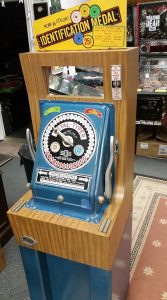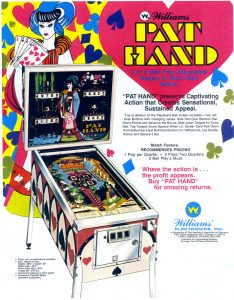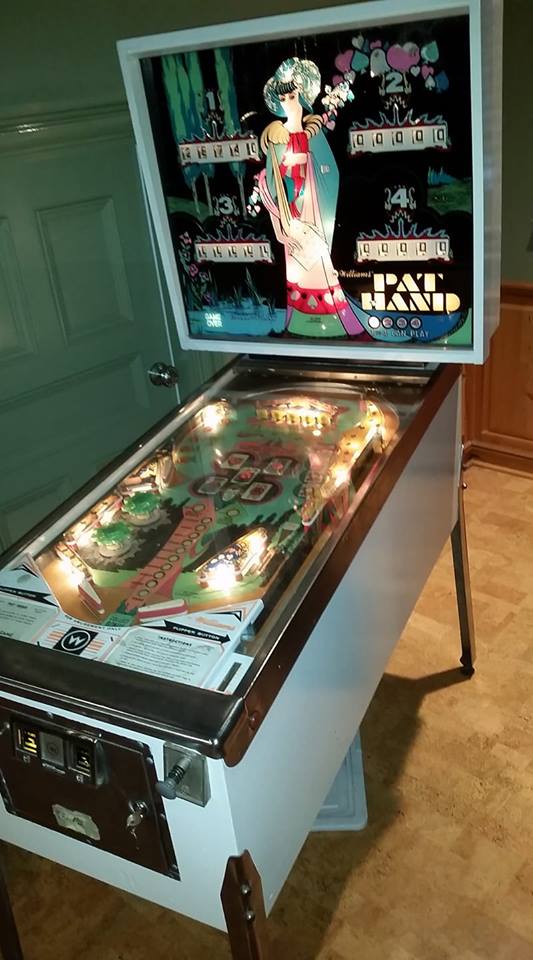Here’s a video I made awhile back that I don’t see linked on my main site so I thought i’d include it. It’s a short video on how to diagnose problems with score reel switches when you turn the game on and the score reels just seem to spin forever and not reset/start the game.
Category Archives: Electro-Mechanical
Diagnosing and replacing a burned-out coil on Gottlieb Card Whiz
This is a short series of videos on fixing a Gottlieb Card Whiz (two player version of Royal Flush) EM pinball machine that was having problems advancing the next player/ball. Upon investigation I discovered a coil that was burned and fell apart when I pulled it out of the assembly. I’ll go over replacing the coil.
First Look: 1975 Ball Air Aces Pinball
Here is a fun video of a new game I picked up – you get to discover the condition of the game along with me… a beautiful condition 1975 Bally Air Aces electro mechanical pinball machine. Let’s see what the deal is with this game?
Repairing/Restoring a Standard Harvard Metal Typer
In this installment, I take a break from pinball repair and work on an interesting old arcade device that is mostly mechanical. In addition to this, it’s a specific machine I remember from when I was in high school and worked at a local amusement park. This device was saved from being taken to the city dump and stored for 30 years until I found it. The challenge is, can it be made to function again? Let’s see!
 This is an interesting mechanical device that will take aluminum “tokens” and allow you to stamp your own messages on them. These were vary popular at carnivals and amusement parks and museums and arcades around the world. The tokens originally cost about 7 cents each, so for a quarter, the operator could make almost 3x his money. But now it’s hard to find the original blanks for under $1 each. Still, this is a very unique piece. These machines were made from the 1930s until the 1980s.
This is an interesting mechanical device that will take aluminum “tokens” and allow you to stamp your own messages on them. These were vary popular at carnivals and amusement parks and museums and arcades around the world. The tokens originally cost about 7 cents each, so for a quarter, the operator could make almost 3x his money. But now it’s hard to find the original blanks for under $1 each. Still, this is a very unique piece. These machines were made from the 1930s until the 1980s.
In this video, I basically have to “reverse-engineer” how the machine works because there is so little documentation on it. I only found one other video online showing the game’s basic operation, so I decided to document my progress with this, including the mistakes I made. This 8 part video series covers the trials and tribulations of getting the machine operational. When I picked it up, it had been sitting in storage for 30+ years. All the movements were seized. I wasn’t even sure if the machine was complete.
Someone who has been working on these machines wrote me about what they’ve learned, and I thought I might share it here:
Ive been on a hobbyist level fixing old pachinkos, digger cranes and metal typers, for about 40 years, i did what you did and learned by hands on.
I just love them, i watched your video and might suggest at some point adding a 9th covering some of the adjustments in the metal typers.
I saw you seemed a bit disappointed in the stamp quailty, im ADD and OCD and it drove me nuts,
I found that the hammer adjustment for too hard or soft has to be in the goldilocks zone and the little place on the hammer has to hit the key dead on and even,
Some filing even welding might be needed on the hammer strike pad.
Then the letters, while the keys are super hard they can rust that will of course ruin it but what i do is clean the the best i can solvent and rag,
I dont want to risk hurting the texture it embosses around the letter, so i got magnifier and a thin strand of copper wire almost like a stiff bristle hair and cleaned in each letter, the copper wire is soft and won’t do damage.
To look clean you would be surprized how much crud is empacted in them,
Then very lite wipe with gun oil, im thinking of trying synthetic clock oil.
As you also must have learned the machines have a few other adjustments,
Also when the hoppers would get low aluminum didnt have a lot of weight and at times a token would slide over/under the stamped token rather than pushing out to the person who printed it, big jam cauysed some machines to be trashed but wasnt hard to unjam,
A lead weight on the top of each hopper tube stack will pretty much fixes that.
Voltage depends on the solenoid but for example one of mine has a 12v solenoid, rather than use old dry cells i run a 9v with a large capacitor, it hits hard and works for a long time in my home,
2 6v lantern batteries will also work and sometimes a plug in 12v supply is used,
But i like the no plug idea.
“The Three Strikes” in pinball appraisal
You might think.. “Is the game working?” is the big critical issue when examining a pinball machine, but a recent trip to look at a game made me want to revisit what are the “three strikes” that make a game less desirable?
Today I had a great example of that.
I got a call from a guy who initially asked about needing pinball repair.
This is always a tough call… because, well, I’m not formally in the pinball repair business, and given the nature of these machines, how old they are, and how often and random they can fail, I don’t like putting myself in a position to charge somebody to fix something, and then offer any kind of warranty/guarantee that the machine will continue to work. It’s just not practical. I like to help people. I want to preserve the hobby, but I can’t go out and fix everybody’s broken game. But every once in awhile I’ll do a house call.
In this case, the guy, as his New Year’s resolution was to clear out space from his house, and the game in question was an old game I fondly remember playing as a child, so I was willing to take a look and see what he might want to take it off his hands.. This is a scenario where the “three strikes”, in combination with other issues, made me not make an offer, and leave the game for someone else and another day.
Here’s the game in question…
When appraising the value of a pinball machine, I like to look at the various elements and go for the “three strikes” rule.
On top of everything is the over-arching question of, “Is it complete?” Are all the parts there? That’s almost a pre-cursor, because if the game is incomplete, the other stuff may not matter as much — it depends upon what’s missing.
Assuming the game is complete, then, “Has it been messed with by un-trained hands?” Is it working, or basically working minus time and use-based problems? It’s one thing if something breaks because of wear. It’s another thing if something stops working because your cat or your 6 year old got in the cabinet and started fiddling with things. The latter scenario can significantly affect the value.
Assuming all that is good, let’s get to the traditional trinity: playfield, backglass, cabinet.
Playfield: You want a game that does not have significant playfield wear. The main perpetrator of this is corroded/rusted balls that are left in the machine. I’ve done articles before elaborating on the damage this can do. You also want to look at the inserts. Are they flat or curved? Are all of them there? In this case, there was an actual insert missing. It’s not necessarily impossible to replace a missing insert. There are still sources for some of these, but there’s always a chance it’s an odd shape and unobtainium. But even if it isn’t, this is another set of steps you have to go through to make the game minimally playable. Most people will examine playfield rubbers, but they really don’t matter. You will always want to replace rubber on a regular basis – it shouldn’t affect the value of the game. On this game there was wear down to the wood in at least 5-6 spots, in addition to the common areas around pop bumpers. Strike one.
Backglass: With backglasses, the key is how well they were maintained? Are they flaking and de-laminating? The artwork on these vintage machines is a primary portion of their value. If there’s significant flaking of the backglass, this is not something easily repaired. It will severely affect the value of the machine. If you’re looking at a game, such as the one in the picture, one thing to note is that there’s not many lights lit up in the head, so the actual condition of the backglass, how much it really is flaking, isn’t apparent when it’s mostly lit from the front. Not only was there cracking and crazing, but it looked like the back had been painted in some spots. It wasn’t the worst I’d seen, but I’d consider the backglass to be strike two.
 Cabinet: It’s all too easy, unfortunately, for a layperson, or quick flipper to re-paint a cabinet. It doesn’t take much effort to just slap some white paint on the cabinet and make the game look much nicer at first glance, but it really does mess with the integrity of the game as a piece of history. The original stenciled designs, as remedial as they were, make up part of the unique artwork of the game. Also these cabinets were rarely painted in solid colors. They had flecks of off-color speckled into the paint. There’s a distinctive style of pinball cabinet paint. I’ve seen many cabinets painted over… it might look better aesthetically to a layperson, but it really tarnishes the value of the game in the eyes of collectors and enthusiasts.
Cabinet: It’s all too easy, unfortunately, for a layperson, or quick flipper to re-paint a cabinet. It doesn’t take much effort to just slap some white paint on the cabinet and make the game look much nicer at first glance, but it really does mess with the integrity of the game as a piece of history. The original stenciled designs, as remedial as they were, make up part of the unique artwork of the game. Also these cabinets were rarely painted in solid colors. They had flecks of off-color speckled into the paint. There’s a distinctive style of pinball cabinet paint. I’ve seen many cabinets painted over… it might look better aesthetically to a layperson, but it really tarnishes the value of the game in the eyes of collectors and enthusiasts.
In this case, all three of these things were issues. I passed on making an offer.
There’s also another lesson to learn here.. if you look at the picture I posted, aside from the cabinet repaint, you can’t see the other issues, but there actually is significantly playfield wear, and significant flaking of the backglass (with lights out in many portions that don’t illuminate the flaws in the backglass). The owner had an inflated idea of what the game was worth. I didn’t want to argue with him. It is unfortunate such complicated, hand-assembled items don’t command the prices people expect, but that’s just the way things are. Someone may pay a premium for their first game, but this isn’t my first rodeo so I left this for someone else.
This isn’t to say the game isn’t worth what the owner wanted. To the right person, especially someone who may be getting their first pinball machine, this could be a special item they’d spend lots of time restoring, just like I did with my first game.
Working on a 1960 Bingo Pinball Machine – Bally Roller Derby
In this episode, we fix a vintage Bingo 25-hole “pinball” machine that has the tilt light stuck on. If you’ve ever wondered what the inside of these monsters look like, check it out.
1963 Gottlieb “Slick Check” – Flipper Maintenance
People were complaining that one of the flippers in our Gottlieb “Slick Chick” was not working properly. The metal was fatigued on the assembly and the switch contacts were well worn, so I’ve ordered new switches and am showing how to remove and replace the flipper switches and make your flippers perform much better.

